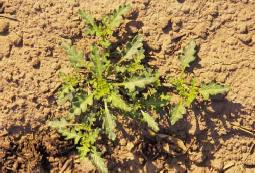
Photo by Oregon State University

Photo by Oregon State University
Cutleaf Nightshade
Solanum triflorum Nutt.
An annual which grows from 4 to 24 inches tall, branched from base, with ill smelling foliage. Leaves are deeply lobed and may have short pubescence. The flowers are small, with white petals and a somewhat enlarging calyx, arranged in groups of 3 and has fruits that are green and contain toxic alkaloids. Found in open, moist to dry sites often with other weeds. Widespread on the Western Plains and found on the Fort Hall Indian Reservation in southeastern Idaho.
Although no specific mention of toxicity has been seen for this species, it belongs to a genus where many, if not all the members, have poisonous leaves and sometimes also the unripe fruits.
Food Uses: Fruit -
raw or cooked. Used in times of food shortage. Eaten as a fruit or vegetable,
the fruit can also be dried, ground into a powder and used with cereals for
making bread etc. The ripe fruit can be boiled, mashed and mixed with ground
chile and salt then used as a condiment with mush or bread.
Medicinal Uses: A
decoction of the berries has been used in the treatment of stomach aches and for
children with diarrhea.
Source